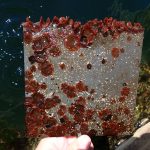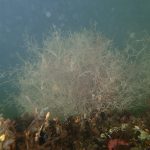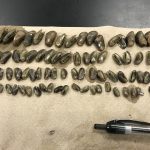|
Mission Bay is a highly urbanized estuary located in San Diego, CA. Locations near the mouth are influenced by tidal exchange with the Pacific Ocean, while locations in the eastern reaches of Mission Bay are most influenced by seasonal freshwater inputs from Rose, Cudahy, and Tecolote creeks; gradients in environmental conditions include temperature, salinity and sediment characteristics. The many docks that harbor boats for recreational activities in the bay and nearby coastal ocean, also support diverse fouling communities. Fouling communities are dominated by non-indigenous, or invasive, ascidians, but diversity of these organisms varies with location with Mission Bay (Tracy 2013, Tracy and Reyns 2014). We have monitored settlement of these organisms using fouling plates deployed at various locations within Mission Bay. |
|
Within Mission Bay, we have examined the settlement patterns of the non-indigenous (1) ascidians: Ascidia zara (Oka, 1935), Botrylloides violaceus (Oka, 1927), Botryllus schlosseri (Pallas, 1766), Ciona intestinalis (Linnaeus, 1758), Ciona savignyi (Herdman, 1882), Didemnum vexillum (Kott, 2002), Molgula ficus (Macdonald, 1859), Polyandrocarpa zorritensis (Van Name, 1931), Styela clava (Herdman, 1881), Styela plicata (Lesueur, 1823), Symplegma reptans (Oka, 1927), Aplidium californicum (Ritter & Forsyth, 1917), Ascidia ceratodes (Huntsman, 1912), Botrylloides diegensis (Ritter & Forsyth, 1917), and Diplosoma listerianum (Milne-Edwards, 1841); and (2) bryozoans: Amathia verticillata (delle Chiaje, 1822), and Watersipora spp.
More recently, we have extended our studies from the docks to the benthic environment, and have been quantifying the abundance and size-frequency distribution of the mussel, Arcuatula senhousia (Benson, 1842).



